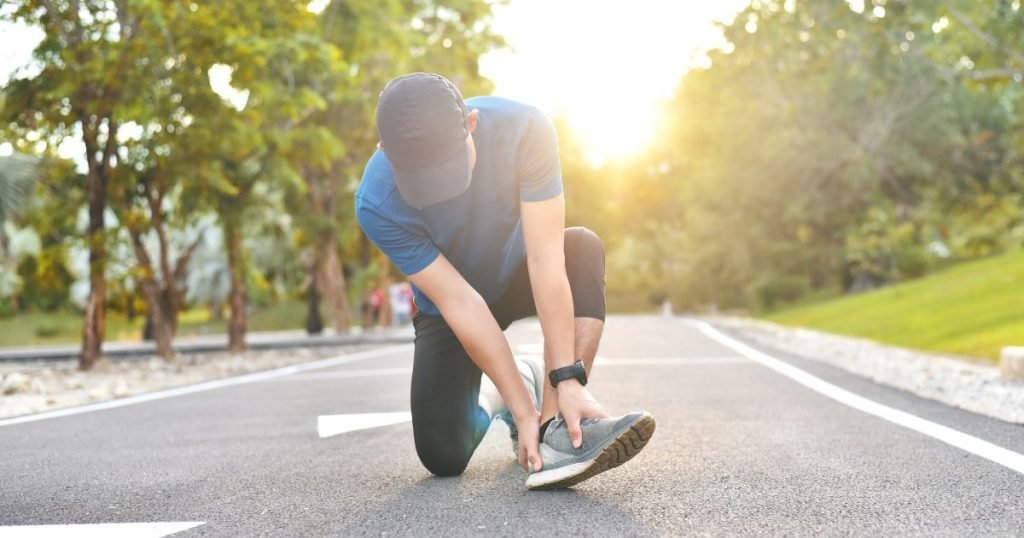Ankle mobility is the unsung hero of fluid movement, impacting everything from basic actions like walking to athletic performance. This guide unveils the secrets to better ankle mobility through targeted exercises that enhance flexibility and strength. Whether you’re an athlete or striving for pain-free movement, these exercises can transform your mobility and overall well-being.
So what’s Ankle mobility?
Ankle mobility refers to the degree of flexibility in one or both of your ankle joints and the surrounding tendons and muscles.
When you have a strong and flexible ankle, you have a significant range of mobility that can help during many daily physical activities.
If you have any kind of weakness or soreness in one or both of your ankles or if you want to improve your existing sports performance, ankle stretching, and exercises can considerably increase your current strength and mobility, help you avoid accidents, assist you in walking correctly and will keep your knee and hip muscles from deteriorating.
Understanding Ankle Mobility:
The ankle joint, formed by bones, ligaments, and muscles, governs dorsiflexion (foot towards shin) and plantar flexion (pointing downward).
Think of it as the gateway to movement efficiency. A healthy range of ankle mobility ensures that weight is distributed evenly as you move, preventing undue strain on other joints like the knees and hips. It’s also a lynchpin in maintaining proper posture, stability, and balance.
But why is ankle mobility so critical?
When ankle mobility is compromised, the domino effect can be felt throughout the body. Walking might feel less effortless, squatting could become a struggle, and engaging in sports might lead to heightened injury risk.
Causes of Poor Ankle Dorsiflexion:
Limited ankle mobility can stem from a variety of factors. Genetic predisposition, excessive body weight (explained in the next section), past injuries, and a sedentary lifestyle can reduce joint flexibility. So, let’s see some of the main causes of poor ankle mobility.
Structural Anatomy: Some individuals have anatomical variations that naturally limit their ankle dorsiflexion. It can include variations in the shape of the ankle bones or tightness in the calf muscles.
Tight Calf Muscles: The muscles at the back of the lower leg, including the gastrocnemius and soleus muscles, can become tight due to factors like lack of stretching, high-heeled shoes, or prolonged periods of sitting.
Achilles Tendon Tightness: The Achilles tendon connects the calf muscles to the heel bone and can become tight and restrict ankle movement upwards. It’s often caused by insufficient stretching or excessive use.
Previous Injuries: Ankle sprains, fractures, or other related incidents have the potential to result in the formation of scar tissue and, subsequently, reduced joint mobility.
Lifestyle Factors: Sedentary lifestyles and prolonged periods of no exercise can lead to reduced ankle mobility over time.
Imbalanced Biomechanics: Some issues with foot pronation (inward rolling) or supination (outward rolling) can really affect ankle alignment and movement,
Muscle Imbalances: Weakness in the muscles that support dorsiflexion, such as the tibialis anterior and extensor digitorum longus, restrict the range of motion.
Postural Alignment: When a person has poor overall posture, especially with excessive anterior pelvic tilt, it can impact ankle alignment and restrict dorsiflexion. Explanation
Age-Related Changes: As individuals grow older, the tissues in their joints may undergo stiffness and reduced flexibility. Consequently, this can lead to a decline in joint mobility, specifically affecting the ankles.
The Impact of Body Weight on Ankle Mobility:
So many factors influence ankle mobility, and body weight is undeniably one of them. While body weight doesn’t directly limit ankle mobility, it can indirectly affect how well the ankle joints function and move. Here’s how body weight comes into play:
Load Distribution: The ankle joint carries the weight of your entire body with each step. Excessive body weight can increase the load on the ankle joint, potentially leading to more wear and tear on the joint over time.
Plantar Fascia Strain: Extra body weight puts more pressure on the plantar fascia, the thick band of tissue along the bottom of the foot. This increased strain can contribute to conditions like plantar fasciitis. As a result, ankle mobility may be indirectly affected due to pain and inflammation.
Impact on Muscle Strength: Carrying excess weight can affect the strength of the muscles around the ankle joint. It should not be underestimated because Weak muscles can result in instability and reduced control over joint movements, potentially impacting ankle mobility.
Inflammation and Swelling: Excess body weight can contribute to inflammation and swelling in the lower extremities, including the ankles. Inflammation can lead to discomfort and restrict joint mobility.

Benefits of Improved Ankle Mobility:
Improving ankle mobility has several benefits that positively affect various aspects of one’s life. Let’s explore the details further.
Effortless Movement:
Adequate ankle mobility allows individuals to effortlessly and smoothly perform everyday movements such as walking and climbing stairs.
Athletic Performance:
Athletes improve their competitive advantage by improving ankle mobility, leading to upgraded agility, increased sprint speed, and elevated jumping abilities.
Balance and Stability:
Improved ankle mobility is crucial for enhancing balance and stability, reducing the risk of falls and injuries, particularly among elderly individuals.
Posture Alignment:
Proper posture and prevention of strain on the spine and hips are directly influenced by ankle mobility. By maintaining good ankle mobility, one can avoid compensatory movements.
Reduced Pain:
Enhancing ankle mobility has the potential to alleviate discomfort linked to conditions like plantar fasciitis, Achilles tendinopathy, and knee pain.
Injury Prevention:
Flexible ankles absorb shock efficiently, and that can lower the risk of overuse injuries in the ankle area.
Functional Independence:
Good ankle mobility allows individuals to maintain independence in various activities such as squatting and reaching.
Physical Confidence:
Feeling agile and stable due to improved ankle mobility can definitely boost overall self-confidence.
Common Signs of Poor Ankle Mobility:
Recognizing the signs of limited ankle mobility can help you identify the need for targeted exercises. Look out for:
Restricted Squatting: Difficulty squatting deeply, often accompanied by heels lifting off the ground.
Heel Cord Tightness: Tightness or discomfort in the Achilles tendon and calf muscles.
Limited Toes-Up Flexion: Struggle to raise the toes towards the shin when the foot is extended.
Instability: Frequent ankle sprains or a wobbly sensation while standing.
Altered Gait: Changes in walking pattern, like limping or rolling the foot excessively.
Ankle Mobility Exercises:
Embark on your journey to improved ankle mobility with these practical exercises:
Calf Stretches:
Gastrocnemius Stretch: Stand facing a wall and place one foot behind the other. Keep the back leg straight and press the heel down, feeling a stretch in the calf.
Soleus Stretch: Like the gastrocnemius stretch, bend the back knee slightly to target the deeper calf muscles.
Dorsiflexion Stretches:
Wall Dorsiflexion Stretch: Stand facing a wall and place your hands on it at shoulder height. Step one foot back and lean in, keeping the heel down and feeling the stretch in the front of the ankle.
Kneeling Ankle Stretch: Kneel on the ground with toes tucked under. Gently sit back on your heels, feeling a stretch along the front of the ankle.
Mobility Drills:
Ankle Circles: Sit or lie down and move your ankle in circles, focusing on the entire range of motion.
Alphabet Writing with Toes: While seated, “write” the alphabet in the air using your big toe, encouraging movement in all directions.
Standing heel lifts:
Stand with your feet about one foot apart. Have a chair or the wall next to you for support if you need it.
Lift your heels off the floor so that you’re standing on the balls of your feet.
Slowly lower your heels to the floor. Control is vital for strengthening your muscles.
Do 2 or 3 sets of 10 lifts each.
Resistance Band Exercises:
Loop a resistance band around a stable anchor. Sit on the ground, secure the band around your forefoot, and gently pull your toes towards you.
Remember to perform these exercises within a pain-free range of motion. Start gently and gradually increase intensity as your ankle mobility improves. Consistency is key to unlocking the full potential of your ankle joints.
Additional Tips for Ankle Mobility Improvement:
Maximize your ankle mobility journey with these practical tips:
Warm-Up: Prioritize a dynamic warm-up, such as light jogging or leg swings, to increase blood flow to the ankle area.
Cool-Down: After exercises, cool down with static stretches to maintain the flexibility gained.
Consistency: Regularity trumps intensity. Aim for daily ankle mobility exercises to see significant improvements.
Patience: Rome wasn’t built in a day, and neither was mobility. Progress may be gradual, but it’s worth the effort.
Listen to Your Body: Discomfort is acceptable, but pain is not. If an exercise causes pain, modify or stop immediately.
Footwear: Opt for shoes supporting natural foot movement and avoid those excessively restricting dorsiflexion, such as high heels.
Physical Therapy: A physical therapist can assess your situation and provide a tailored exercise program to improve ankle mobility.
Manual Therapy: In some cases, manual techniques performed by a healthcare professional, such as joint mobilizations, can help improve ankle mobility.
With dedication and these tips in your arsenal, your ankle mobility will undoubtedly flourish and improve.

Precautions and Modifications:
While ankle mobility exercises can be immensely beneficial, it’s crucial to consider individual circumstances and potential limitations such as:
Existing Injuries: If you have a history of ankle injuries, consult a healthcare professional before beginning any mobility exercises.
Medical Conditions: Certain conditions might affect your ability to perform specific exercises. Seek guidance if you have concerns.
Pregnancy: Pregnancy-related changes may impact your balance and joint stability. Opt for seated or supported exercises if needed.
Progression: Gradually increase the intensity of exercises to avoid overloading the joints. Start with lower resistance or shorter holds.
Age: As we age, joint flexibility might change. Focus on gentle mobility exercises and prioritize safety.
Things to remember.
Remember, every individual’s body is unique. If an exercise feels uncomfortable or causes pain, modify or skip it. Your safety and well-being come first.
Regardless of age, activity level, or starting point, ankle mobility exercises can truly enhance physical performance, comfort, and overall quality of life.
Remember, this journey requires dedication and patience, but the rewards of improved mobility, reduced pain, and increased confidence are immeasurable.












